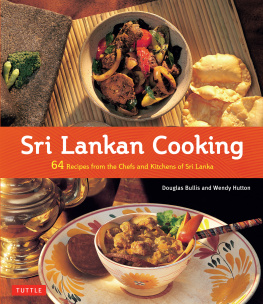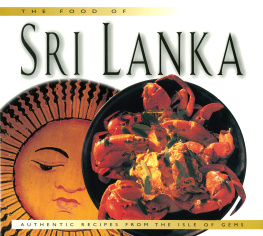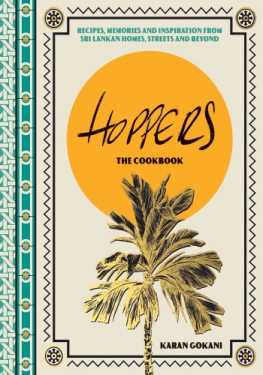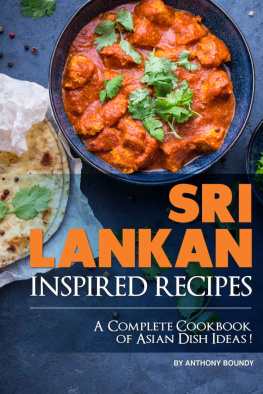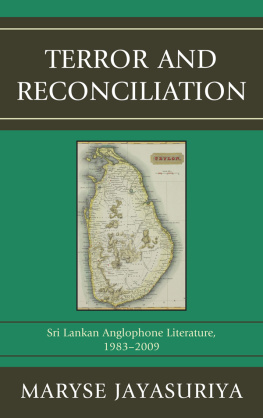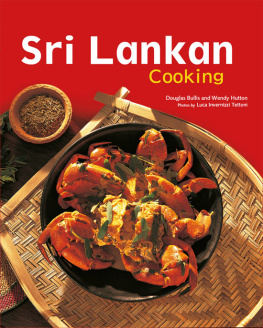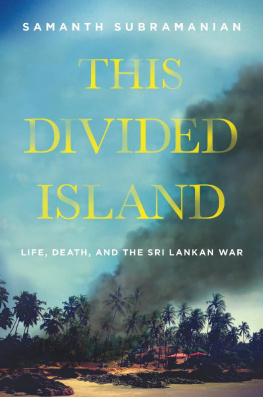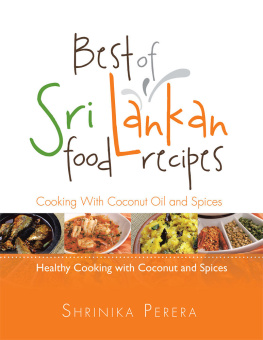Acknowledgements
The recipes in this book were created by the chefs at the following Sri Lankan hotels:
Heritance Kandalama Hotel
Tel: +94 66 555 5000
kandalama@heritancehotels.com
www.heritancehotels.com
Chef Senaka Perera
Cinnamon Grand Colombo
Tel: +94 11 243 7437
grand@cinnamonhotels.com
www.cinnamonhotels.com
Executive Sous Chef KMR
Morugama
Chef Leo Perera
Chef HB Piyasena
Chef KDML Niranjan
Chef Kishore Reddy
Lighthouse Hotel
Dadella, Galle
Tel: +94 91 222 3744
lighthouse@lighthouse.lk
www.jetwing.com
Executive Chef Mohan T Kulathunge
Mount Lavinia Hotel
Tel: +94 11 2711 711
mount.lavinia@mtlavinia.com
www.mountlaviniahotel.com
Chef Publis
Blue Oceanic Hotel
Negombo, Sri Lanka
Tel : +94 31 227 9000
blueres@sltnet.lk
www.jetwing.com
Executive Chef Gamini Thambugala
Yala Safari Game Lodge
www.jetwing.com
Executive Chef Jayantha Ekanayake
Special Thanks
The publisher would like to thank Mount Lavinia Hotel, The Lanka Oberoi, Jetwing Hotels Ltd and Aitken Spence Hotel Management (Pvt) Ltd, for their generous support and assistance in producing this book.
Many individuals contributed recipes, information and assistance in preparing this book. We wish to thank Sanath Ukwatha, Bazeer Cassim and the staff of the Mount Lavinia Hotel; Ananda Yapa of the International Hotel School, Mount Lavinia for his endless patience explaining the fine points of Sri Lankan ingredients and to Philomena de Lanerolle for typing them up; Stefan Pfeiffer, Narmada L Mller and Chef Helmut Hubele of the Lanka Oberoi in Colombo; Hiran Cooray, Kumara Seneratne and Ruvinika Seneratne of Jetwing Hotels, Ltd.; Gemunu Goonewardene and S Amal Nanayakkara of Aitken Spence Hotel Management (Pvt) Ltd; Mrs Indra Rani Lavan Iswaran for her assistance in the selection of recipes; Mario de Alwis of Mas Tropical Food Processing, Pvt Ltd; Ahsan Refai of Zam Gems and the staff of their shop at the Lanka Oberoi; Al-hajj MHA Gaffar and Al-hajj AG Kamal of the Historical Mansion in Galle; Lucky Perera of Lanka Hands for the use of backdrop items in the photos, Ms Deloraine Brohier and Graham de Kretser for their information about the Dutch Burgher cooking traditions; Nissanka Goonasekera of Giragala Village in Mirissa; Mr & Mrs Shanti Perera of Sunray Beach Villa in Mount Lavinia; Mrs. Tissa Warnasooriya and PP Hettiarachchi of the Ceylon Tourist Board; George Michael of the Ministry of Tourism; and Lawrence Wheeler. Thanks also to Chefs Kishore Reddy and Jayantha Ekanayake for reading the manuscript and suggesting improvements.
Mail-order ingredients
Most of the ingredients used in this book can be found in markets featuring the foods of Sri Lanka and India, as well as in other Asian foodstores and large supermarkets. Ingredients not found locally may be available from the mail-order markets listed below.
NORTH AMERICA
A Cooks Wares
Tel: 724-846-9490
sales@cookswares.com
www.cookswares.com
Maha Bazaar
service@mahabazaar.com
www.mahabazaar.com
Penzeys Spices
Tel: (800) 741 7787
Fax: (414) 760 7317
www.penzeys.com
The Spice House
Tel: (847) 328 3711
www.thespicehouse.com
EUROPE
Bristol Sweet Mart
Tel: +44117 951 0690
sales@sweetmart.co.uk
www.sweetmart.co.uk
Taj Stores
Tel: 0207- 377 0061 or 247 3844
info@tajstores.co.uk
www.tajstores.co.uk
AUSTRALIA
Mannys House of Spices
Tel: (02) 46485808
info@mannyspices.com.au
www.mannyspices.com.au
Banking on Tea
Or how the word Ceylon was immortalised
A serendipitous twist turned a disastrous blight of coffee rust, which swept through the islands coffee estates in the 1870s, into a tea bonanza: the pretty but unassuming little bush became Sri Lankas chief export and immortalised the word Ceylon. A few tea plants brought from China took very well to the cool, crisp highland climate of the Looloocondrie Estate near Kandy. The islands planters were much relieved to find that tea plants love the same climate that coffee does and that tea has just as enthusiastic a following all around the world.
Converting a green leaf into a tasty brown beverage is a quite a story in inorganic chemistry. Yet it is an everyday event in the slab-sided white or aluminium-painted tea factories that dot the flowing hills. These are slatted with louvres to hasten the drying process. Within them the three steps of withering, grinding and fermenting, convert the fresh leaves to a moist, black mass which is then heated in a stove to reduce to two percent all the moisture originally contained in the leaf.
Once broken into flakes, tea is graded into names based on the size of the flake. These names have the kind of arcane character often emanating from professionals when talking to each other. In the case of tea, the size categories are pekoe, orange pekoe, broken orange pekoe, broken orange pekoe fannings, and dustthe latter a low quality, inexpensive tea that finds its way into many of the worlds teabags.
The graded teas are auctioned and exported, with the buyers relying on the expertise of their own tasters to guide them. The subtle variants of flavour in the vocabulary of tea are reminiscent of the argot wine-tasters use. Expert tasters classify tea into categories such as malty, pointy, bakey, thick, coppery, dull, and bright according to strength, flavour and colour.
The hill country where the best teas are grown is perhaps the most scenic part of Sri Lanka. Miles of lush green foliage and forest undulate across the hills and pickers move among the rows like vividly coloured butterflies.
Douglas Bullis

A hill country tea plantation.
Basic recipes
Roasted curry powder
This is used as an ingredient in curries or can be sprinkled on vegetables before serving.
1/2 teaspoon fennel seeds
1/2 teaspoon cumin seeds
1/2 teaspoon fenugreek seeds
1/2 teaspoons cinnamon powder
6 cardamom pods
100 g (1/2 cup) coriander seeds
6 cloves
Dry-roast all the ingredients in a frying pan over low heat, stirring constantly, until the spices become a deep golden colour. Grind them to a fine powder in a mortar or blender. Store in an air-tight container.
Unroasted curry powder
100 g (1/2 cup) coriander seeds
1/2 teaspoon fennel seeds
1/2 teaspoon cumin seeds
1/2 teaspoon fenugreek seeds
1/2 teaspoon cashew nuts
1 medium cinnamon stick
1 stalk lemongrass, tender inner part of bottom third only 6 cardamom pods
6 cloves
1/2 teaspoon fresh ginger
1/2 tablespoons peppercorns
1/2 teaspoon mustard seeds
80 g (1/2 cup) ground uncooked rice
Place all the ingredients except the ground rice in a blender and blend to a fine powder. Stir in the ground rice. Store in an airtight container. If kept frozen, this curry blend will remain fresh for a long period of time.

Two or three sambols or dips, are served with every Sri Lankan meal.

Bitter gourd sambol
250 g (8 oz) bitter gourd, finely sliced
1 teaspoon turmeric powder
Oil, for frying
150 g (3/4 cup) finely sliced onion
2 green finger-length chillies, finely sliced

